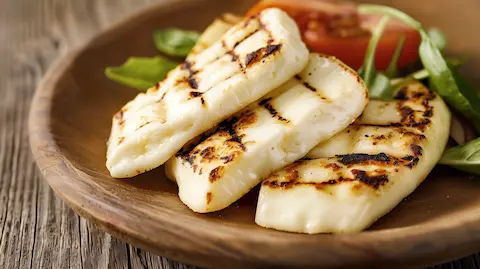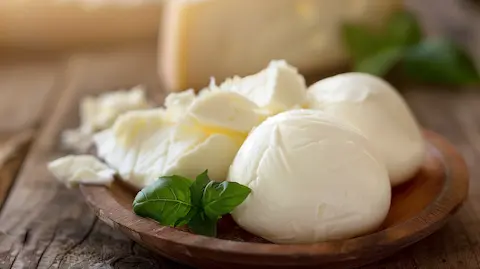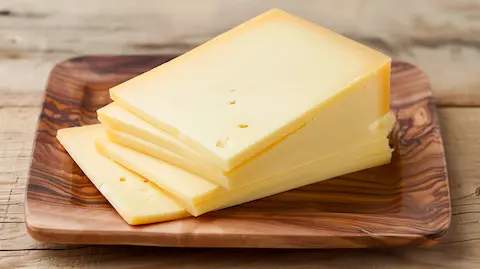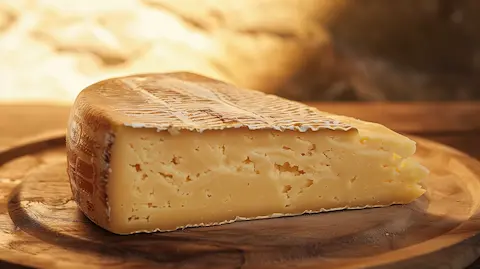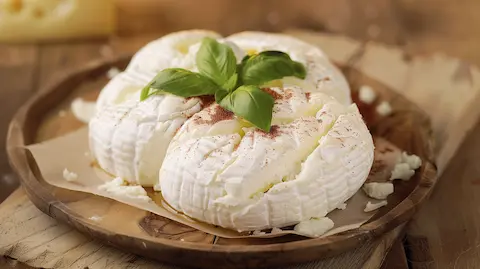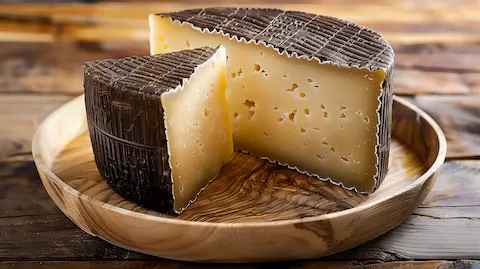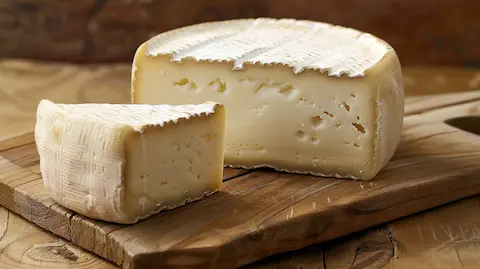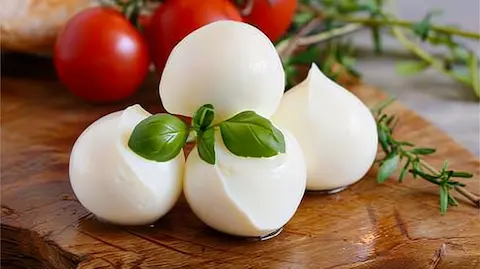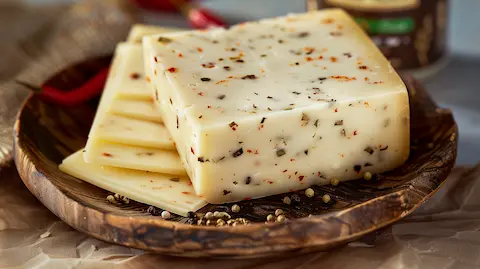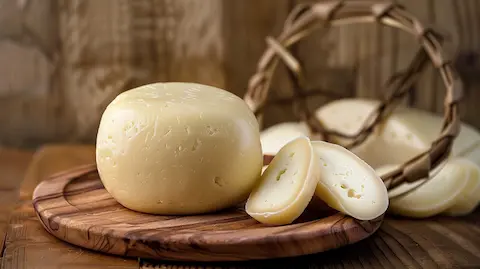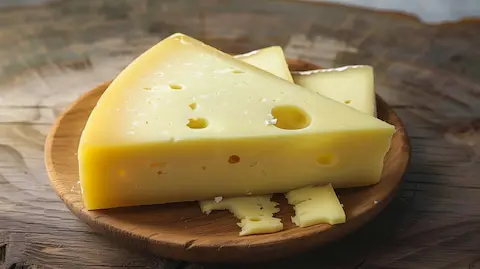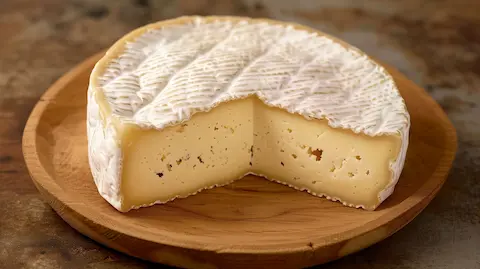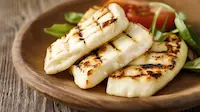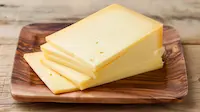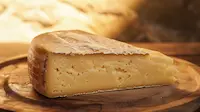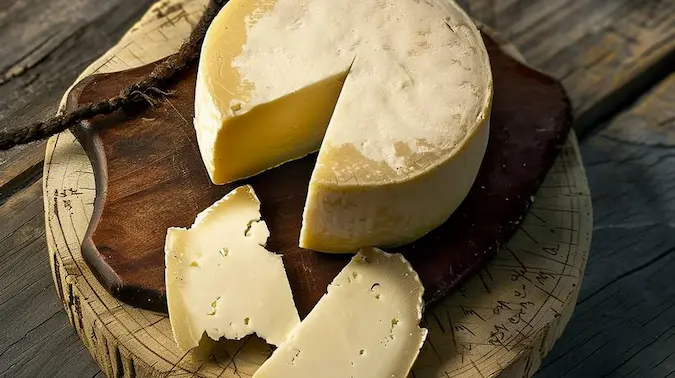Ulloa cheese
Ulloa is a soft, creamy cheese that comes from the lush region of Galicia in northwest Spain. Made primarily from the milk of Friesian cows, this cheese carries a mild, slightly tangy taste with a buttery finish that melts on the palate. The smooth, pale yellow paste of Ulloa is encased in a soft, bloomy rind, a result of careful aging for a minimum of two weeks. This cheese is a testament to the rich dairy traditions of Galicia, where the damp, cool climate contributes to the high-quality pastures and hence, the exceptional milk used for Ulloa’s production.
Galician cheesemakers have honed their craft over generations, creating ulloa through a process that combines time-honored techniques with a deep understanding of the local environment. This cheese is not just a culinary treat but also a slice of Galician culture, enjoyed both within Spain and by cheese lovers around the world. Whether served on a cheeseboard, melted into a comforting dish, or savored as a simple snack, Ulloa invites you to explore the rich tapestry of Spanish cheesemaking.
How is Ulloa made?
Ulloa cheese is made by pasteurizing cow's milk and then adding specific strains of lactic bacteria to start the fermentation process. Rennet is introduced to coagulate the milk, forming curds which are subsequently cut and gently stirred. The whey is drained, and the curds are molded and pressed to expel remaining liquid. The young cheese is then salted and left to age in a controlled environment, where it develops its characteristic flavor and texture.
Here is a detailed breakdown of the production process:
Ulloa Cheese Production Process
| Step | Description | Ingredients | Temperature | Duration |
|---|---|---|---|---|
| 1. Pasteurization | Milk is heated to eliminate harmful microbes and prepare for fermentation. | Cow's milk | 72-75°C (161-167°F) | 15-20 seconds |
| 2. Fermentation | Lactic bacteria are added to milk, initiating the fermentation process. | Lactic bacteria cultures | 30-32°C (86-90°F) | 1-1.5 hours |
| 3. Coagulation | Rennet is added to form curds. | Rennet | 30-32°C (86-90°F) | 30-40 minutes |
| 4. Cutting and Stirring | Curds are cut and gently stirred to separate from the whey. | 32-34°C (90-93°F) | 20-30 minutes | |
| 5. Molding and Pressing | Curds are placed into molds and pressed to shape the cheese. | Room temperature | 2-4 hours | |
| 6. Salting | The cheese is salted to enhance flavor and preservation. | Salt | Room temperature | 1-2 days |
| 7. Aging | Cheese is aged in a controlled environment to develop its unique characteristics. | 10-12°C (50-54°F) | Minimum 2 weeks |
What does Ulloa taste like?
Ulloa tastes like a harmonious blend of mild tanginess and buttery richness. Its soft texture complements its delicate creaminess, while the subtle grassy notes reflect the verdant pastures of Galicia. The cheese’s flavor profile is rounded out by a slight lactic tang, making it a versatile choice for both cooking and direct consumption.
Ulloa cheese profile
Exploring the specifics of Ulloa cheese reveals the nuances that make it a beloved choice among cheese aficionados. To truly appreciate Ulloa, one must become acquainted with its distinct characteristics:
- Made from: Pasteurized cow's milk
- Country of origin: Spain
- Region: Galicia
- Family: Soft-ripened
- Type: Soft cheese
- Texture: Creamy and smooth
- Rind: Bloomy
- Colour: Pale yellow
- Flavour: Mild with a buttery finish
- Aroma: Milky with a hint of tanginess
- Vegetarian: Not typically, due to the use of animal rennet
- Producers: Small-scale artisanal cheesemakers in Galicia
- Safe for pets: Cheese is not recommended for pets, and Ulloa should be avoided due to its lactose content and potential for digestive upset
- PDO status: Not applicable
Ulloa cheese originates from the verdant region of Galicia in northwest Spain. This area is renowned for its high-quality dairy production, thanks to the lush pastures and favorable climate that provide ideal conditions for the Friesian cows whose milk is used to craft Ulloa cheese. This geographical influence is integral to the cheese's identity and contributes to its unique taste and texture.
How to store Ulloa?
Proper storage of Ulloa cheese is key to preserving its delicate flavor and creamy texture. In the refrigerator, Ulloa should be wrapped in wax or parchment paper, which allows the cheese to breathe and maintain optimal humidity levels. For additional protection, place the wrapped cheese in a plastic container or wrap it with a layer of plastic wrap to prevent it from absorbing other flavors and aromas in the fridge.
- Wrap in Paper: Encase Ulloa in wax or parchment paper to allow for breathability.
- Secondary Barrier: Add a layer of plastic wrap or place in a plastic container for extra protection.
- Refrigerate: Store the wrapped cheese in the main body of the refrigerator, not the door, to ensure a consistent temperature.
- Check Regularly: Inspect the cheese for any signs of spoilage and to ensure the wrapping is intact.
How long does Ulloa cheese last?
Ulloa cheese can be enjoyed at its best quality when consumed within a few weeks of purchase. If stored properly in the refrigerator, it can last for up to three weeks. Freezing Ulloa is not recommended as it can significantly alter the cheese's texture and flavor. When thawed, the cheese may become crumbly and lose some of its creamy mouthfeel and delicate taste.
| Storage Location | Shelf Life | Texture After Thawing | Taste After Thawing |
|---|---|---|---|
| Outside | 2 hours | ||
| Fridge | Up to 3 weeks | ||
| Freezer | Not recommended | Crumbly | Milder in flavor |
Is Ulloa cheese pasteurized?
Yes, Ulloa cheese is made from pasteurized cow's milk. The pasteurization process ensures the milk is free from harmful bacteria, making the cheese safe for consumption while still capturing the essence of Galicia's rich dairy tradition.
Can you freeze Ulloa?
No, it is not recommended to freeze Ulloa cheese. While freezing can extend the shelf life of some cheeses, for Ulloa, it compromises the texture and flavor. The cheese may become crumbly and lose its characteristic creamy mouthfeel, diminishing the overall sensory experience that Ulloa is known for. To enjoy Ulloa at its best, stick to refrigeration as your storage method.
Alternatives to Ulloa cheese
Seeking alternatives to Ulloa cheese can be a delightful opportunity to explore other cheeses with similar textures and flavor profiles. Whether you're unable to find Ulloa or simply wish to experiment with different cheeses, the following table offers a curated selection of substitutes that provide a comparable experience. These alternatives have been chosen for their ability to capture the essence of Ulloa's creamy texture and mild, buttery flavor, ensuring that your culinary endeavors remain authentic and enjoyable.
Ulloa cheese substitutes
| Cheese | Origin | Milk Source | Texture | Flavor | Aging Time | Best Used In |
|---|---|---|---|---|---|---|
| Tetilla | Spain | Cow | Soft to semi-soft | Mild, slightly sweet | 7-30 days | Snacking, melting in dishes |
| Brie | France | Cow | Soft | Buttery, creamy | 4-5 weeks | Cheese boards, baking, sandwiches |
| Camembert | France | Cow | Soft | Rich, buttery | 3-5 weeks | Cheese boards, baked dishes |
| Port Salut | France | Cow | Semi-soft | Mild, savory | 1-2 months | Snacking, sandwiches, cheese boards |
| Havarti | Denmark | Cow | Semi-soft | Buttery, slightly acidic | 3 weeks | Sandwiches, salads, melting |
| Requesón | Spain | Cow or goat | Soft, creamy | Mild, milky | Fresh | Spreads, desserts, fillings |
Ulloa popular comparison
Brie is often a cheese that comes to mind when considering a counterpart to Ulloa. Both cheeses boast a creamy, soft texture and a mild flavor that makes them favorites on the cheese board. However, Brie has a more pronounced earthy, mushroom-like undertone due to its unique aging process, offering a different dimension to the palate.
Ulloa vs. Brie
| Cheese | Origin | Milk Source | Texture | Flavor | Aging Time | Uses |
|---|---|---|---|---|---|---|
| Ulloa | Spain | Cow | Soft, creamy | Mild, buttery | Minimum 2 weeks | Cheese boards, melting in dishes |
| Brie | France | Cow | Soft | Rich, buttery with earthy undertones | 4-5 weeks | Cheese boards, baking, sandwiches |
How to use Ulloa
Ulloa's creamy consistency and mild flavor make it a versatile ingredient in both hot and cold dishes. To cut Ulloa, a smooth wire cheese cutter or a sharp knife is ideal, ensuring clean cuts without sticking. It can be spread on crackers, melted into risottos, or used as a sumptuous topping for pizzas. Its mellow taste also makes it a perfect addition to cheese sauces, complementing rather than overpowering other ingredients.
- Spreading: Enjoy on bread or crackers for a simple appetizer.
- Melting: Incorporate into pasta dishes, omelets, or over vegetables.
- Baking: Use as a topping for pizzas or flatbreads.
- Snacking: Pair with fruit or nuts for a quick and satisfying treat.
- Cheese boards: Feature alongside other cheeses, charcuterie, and accompaniments.
How to serve Ulloa cheese
Ulloa cheese is best savored at room temperature to fully appreciate its creamy texture and subtle flavors. Serve as part of a cheese platter with crusty bread, fruit preserves, and a selection of nuts. For a touch of elegance, drizzle with honey or a balsamic glaze. When entertaining, consider offering a variety of textures and flavors on your cheese board, including Ulloa, to cater to all palates.
Recipes using Ulloa
Ulloa's soft texture and mild flavor profile make it a prime candidate for a host of recipes. It melts beautifully, lending a velvety richness to warm dishes, and its subtle taste does not overpower other ingredients, making it an excellent companion in a variety of culinary contexts.
- Ulloa Quesadillas: The cheese's meltability makes it perfect for a gooey, comforting filling between tortillas.
- Creamy Ulloa Dip: Mixed with herbs and spices, Ulloa becomes a crowd-pleasing spread for bread or crackers.
- Vegetable Gratin with Ulloa: The cheese adds a luxurious layer to baked vegetable dishes.
- Stuffed Chicken Breast: Ulloa can be used to stuff meats, complementing the savory flavors with its creamy texture.
- Ulloa and Pear Crostini: The mildness of Ulloa pairs well with the sweetness of pears, creating an elegant appetizer.
Ulloa nutrition data
There are 264 calories in Ulloa cheese per 100g. Ulloa is a source of protein and calcium, important for bone health, but it also contains saturated fat and sodium, which should be considered within the framework of a balanced diet.
| Nutrient | Amount per 100g | % Daily Value* |
|---|---|---|
| Calories | 264 | - |
| Total Fat | 21g | 32% |
| Saturated Fat | 14g | 70% |
| Cholesterol | 90mg | 30% |
| Sodium | 620mg | 26% |
| Total Carbohydrates | 0.5g | <1% |
| Dietary Fiber | 0g | 0% |
| Sugars | 0.5g | - |
| Protein | 18g | 36% |
| Calcium | 530mg | 53% |
*Percent Daily Values are based on a 2,000 calorie diet. Your daily values may be higher or lower depending on your calorie needs.
What's next? WhatCheese insights
If you are a connoisseur or simply a curious foodie, finding Ulloa cheese can be a rewarding quest. Specialty cheese shops, particularly those with a focus on Spanish or European cheeses, are likely to stock Ulloa. For those who prefer the convenience of online shopping, there are numerous gourmet food websites that offer Ulloa, often with detailed descriptions and serving suggestions. Additionally, some larger supermarkets with expansive cheese selections may carry Ulloa, especially in cosmopolitan areas with a demand for international cuisine.
If you are keen to experience Ulloa in a more immersive setting, keep an eye out for cheese and wine events, which often feature a selection of fine cheeses including Ulloa. These events can be a fantastic way to learn directly from cheesemongers about the subtleties of Ulloa and how to pair it with the perfect wine. Moreover, culinary workshops and cheese appreciation classes are increasingly popular, and they frequently include cheeses like Ulloa to educate participants about the diversity of cheese textures and flavors.
For those who enjoy the creamy and mild characteristics of Ulloa, exploring other cheeses in the soft cheese category can be quite satisfying. Cheeses like Stracchino, Robiola, and Saint André offer similar indulgent textures and delicate flavors that pair wonderfully with a variety of accompaniments and wines.

